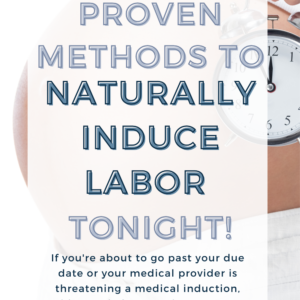Did you know that there are four stages of labor and delivery? Nope – it’s not just contractions! If you’re expecting, it’s essential to know and understand the different stages of labor. Prepare your body and mind and feel at peace for what’s to come by learning about the very different stages of labor and what they mean for you and baby.

[convertkit form=1775034]
The Four Stages of Labor
- Dilation and contractions
- Pushing and birth
- Placenta delivery
- First 1-2 hours postpartum
It sounds simple, but so much happens during each of those stages! If you’re wondering if you need to know these stages, the answer is yes! It’s especially important if you want an unmedicated natural birth. The more you know about what to expect during labor and delivery, the higher your chances are in having a successful natural birth.
Hearing that there are four different stages of labor and delivery may sound confusing. As you continue to read, you’ll learn that
Related: 14 Tips You Need for Natural Birth
The First Stage of Labor – Dilation and Contractions
.This is the stage you’re probably most familiar with. The first stage of labor begins with contractions and ends when you are fully 10 centimeters dilated.
It’s the longest of the four stages and is broken down further into three parts.
- Early Labor
- Active Labor
- Transition
Early Labor
Early labor is typically defined as the stage where you dilate from 0-4 centimeters. However, this can vary from mama to mama for a few different reasons. If baby has been sitting in the birth canal for a while and putting pressure on the cervix, you be 1-3 centimeters for several weeks before actual labor. If this isn’t your first baby, you may dilate early.
Neither of these circumstances mean you are in the first stage of labor. Actually, the first stage of labor has more to do with contractions and contraction pattern than it actually has to do with cervical dilation.
Early labor usually consists of regular contractions that get you to four centimeters dilated. Contractions can be somewhat irregular but trend towards a somewhat predictable pattern or become more regular as you near four centimeters dilated.

The emotional signpost of this stage is excitement. You think you’re having contractions and that labor has started but aren’t super sure. Either way, you’re excited!
Contractions feel like a strong cramping, like a period. They’re noticeable but don’t cause you to stop and focus nor do they interfere with daily life or tasks.
This stage can last hours or even days! So no need to fret packing your hospital bag or calling your midwife. This stage is best spent preparing your body and mind for what’s to come. Rest and save your energy for stages of labor and pushing that are to come. As you progress through labor and delivery, you may lose your appetite or even feel nauseous. Use this time to drink plenty of water to stay hydrated for birth. Eat lots of nutritious foods.
It’s possible, but not guaranteed, that you have your bloody show (lose your mucus plug). You’ll likely have several bowel movements as your body prepares to focus only on labor and move into the other stages of labor.
Active Labor
Active labor is when your cervix dilates from 4-7 centimeters. At this point, contractions are regular and the intensity has increased. This is typically when most women get epidurals if that’s your chosen method of pain management during labor and delivery.
This substage can also last hours. It can also vary! Whether you’ve had babies before, how many weeks gestation you are can all alter the length of this stage.
You should also remember that labor and delivery works on its own time. There’s no math to it. For example, just because it took you so many hours to dilate from 4-5 centimeters, doesn’t mean it will take the same amount of to dilate from 5-6cm. That’s why it can be beneficial to forgo cervical checks and instead rely on your own intuition and the emotional signposts to drive your labor.
No matter how long this stage lasts for you, this is when the real work begins. Contractions are stronger than the early stage of labor. They take focus and require your full attention.
You’re now in the serious emotional signpost. You will lose modesty, instead focusing on comfort, your contractions and relaxing your mind. You’ll lose track of the real world, focusing on just your body and labor.
Your bag of waters may break during this time, but not always. Once your contractions last longer than 60 seconds and are 3-4 minutes apart (from the start of one to the start of another) it’s time to head to the hospital, birthing center or call your midwife.
During this time, work with your birth team to adapt your surroundings to your ideal birth environment. Stay relaxed so your contractions can appropriately work to dilate and efface your cervix. Find comfort by alternating labor positions, bouncing on an exercise ball, or walking. Lastly, be sure to drink plenty of water in between contraction to stay hydrated.
One you’ve dilated to about 7 centimeters, you’re onto the next stage.
Transition
Transition is when you dilate from 7-10 centimeters and become completely dilated and effaced. It’s the shortest and once you hit transition, you’re SO close to meeting your baby.
If you’ve gotten an epidural, you can just hang out, continue changing labor positions and wait in until the pushing stage.
If you want to have an unmedicated natural birth, this is the stage that will make or break your dream birth story. But listen up! It’s not that contractions get THAT much harder, it’s that your mentality changes.
Your contractions may become irregular – having two in a row, have a stronger peak of intensity or have two peaks in a row. You’ll become sweaty and shaky. Your bag of waters may break if it hasn’t already. At this point, labor has been ongoing for several hours. You’ll want to give up and wonder if you can do it any longer. You may consider getting an epidural. Some mamas have irrational thoughts, like they want to take a break or go home.
This substage of labor marked as the self-doubt emotional signpost. As soon as you start having thoughts about wanting to give up, or that you can’t do it any more – just remember that this means you’re minutes away from meeting baby!
During this stage, you’ll want to lean on your support person as much as possible. It’s also where all of your childbirth education and natural birth preparations are going to be KEY! (By the way, learn everything you need for your unmedicated natural birth plan in the Natural Birth Bundle. Check it out HERE.)
The good news is is this stage of labor is the shortest! Of course, it differs for every women, especially if you’ve had babies previously. But it can last anywhere from a few minutes to about an hour.
Once your cervix is complete, which means totally dilated and totally effaced, you’re ready to move on to one of the next stages of labor!
The Second Stage of Labor – Pushing
Now that you’ve got one of the longest stages of labor out of the way, it’s time to start pushing!
The second stage of labor begins when your cervix has hit 10 centimeters dilated and 100% effaced, AKA complete. That means you’re totally dilated and thinned out. It ends with the delivery of your baby.
If you’re getting cervical checks, your HCP will let you know when you’re “complete”. if you have an epidural, this will be the indication that’s it’s time to push. If you’re a natural mama, being complete can be the indication you need to push; however, it’s best to wait until you feel the urge and sensation to push.
You’ll know when it’s time to push because you’ll literally feel your body bearing down and pushing baby out. If you’re not yet feeling the urge, it’s okay to wait. It means your body or baby aren’t yet ready. Starting to push before your body is ready can lead to longer and harder pushing time.
And believe it or not, pushing will be a relief!
Like all stages of labor, the length of time will depend on a lot of things and can vary from mama to mama. Some mamas push one time and their baby is born! However, if you’re a first time mom, it’s likely that pushing will take a little longer and require more than just one push. First time mamas push anywhere from 1-2 hours. Veteran mamas push way less!
It also depends on whether or not you get an epidural.
Related: 9 Amazing Benefits of Unmedicated Natural Birth
Pushing With an Epidural VS No Epidural
FACT: If you receive an epidural during labor, you will more than like push longer than an unmedicated mama.
Epidural mamas need more direction and practice to get into a good pushing routine at this stage of labor. It’s harder to push with an epidural.
When you’re unmedicated, your body’s design and natural instincts are to contract, bear down and push baby out. You will literally feel this sensation and be unable to fight it. In fact, it’s your natural instinct to work with your body and push when you feel this sensation and delivery baby.
If you’re an epidural mama, you won’t feel this sensation, or it won’t be as strong (depending on how strong your epidural is). Therefore, a nurse may need to tell you when to push. She’ll read the monitor, and when she sees a contraction build, she’ll tell you to push. The only problem is the monitor isn’t exactly timed to your body. By the time your contraction is noticed on the monitor, it may already have taken place a few seconds. This means less pushing and progress than a natural mama who’d been pushing since she felt the contraction.
Additionally, because your feeling is lessened due to the epidural, your muscle contraction and pushing won’t be as forceful and strong when you bear down, which also leads to longer pushing time.
Either way, epidural or unmedicated natural birth, once you push baby out and meet your sweet bundle of joy, you’re onto the next stage of labor.
The Third Stage of Labor – Delivering the Placenta
This is definitely the shortest out of all of the stages of labor.
The third stage of labor begins from the time baby is delivered and ends once you’ve delivered the placenta.
This stage typically lasts anywhere from 30-45 minutes but can be as short as 4-5 minutes.
Several minutes after baby is born, the umbilical cord will stop pulsating (baby stops receiving blood flow from the umbilical cord) and you or your partner or whomever can cut the cord. You can read more about delayed cord clamping HERE.
Once the cord stops pulsing, your placenta begins to understand that baby’s been delivered and can begging to detach from the uterus.

Your placenta is a large organ that needs birthed from your vagina. It won’t just fall out. Your body will either continue to contract on it’s own until the placenta comes out. Or you may need to assist a little and push it out. But don’t worry, it will just be small pushes – not like baby!
It will feel like delivering a big bowl of Jell-O. It’s warm and slippery-feeling when it comes out. Some mamas choose to encapsulate it, some save and eat it, and most let it be discarded.
Most mamas don’t even notice this stage of labor. You’re either working on nursing or in such awe of your newborn and what your body just did that placenta delivery is a breeze.
Sometimes the placenta doesn’t get the idea that its job is done. Depending on your HCP, they’ll either tug on the cord to encourage detachment, let it detach on its own or will go up in and extract it. Be sure to talk with your HCP ahead of time if you have a preference.
The Fourth Stage of Labor – The First 1-2 Hours After Birth
This is the fourth and final stage of labor and delivery. It begins once your placenta is out and ends around 1-2 hours postpartum.
It’s during this time that your uterus continues to contract down to begin returning to pre-pregnancy size. The contractions will be minimal or feel like a period cramp. You’ll notice them especially during the fourth stage of labor and even the few days following labor and delivery.
If you’re a nursing mama, you’ll notice these contractions a lot when nursing. The oxytocin released during nursing encourages contractions, which often speeds uterine healing.
Regardless, you’ll be monitored closely during the fourth stage of labor. In fact, you probably will stay in your birthing suit until cleared by your nurses or HCP. They’ll make sure that your uterus is contracting appropriately. Bleeding will be monitored to make sure its normal and vital signs will be checked often.
During this time, you should be doing skin-to-skin to bond with baby. Nursing and latching can be worked on.
Conclusion
There you have it! The four stages of labor and what they mean for labor and delivery and you and baby.
Understanding the stages of labor is so important to know as your body begins labor. The more you know, the more smoothly and painlessly labor will go – especially if you’re an unmedicated natural mama.












Leave a Reply